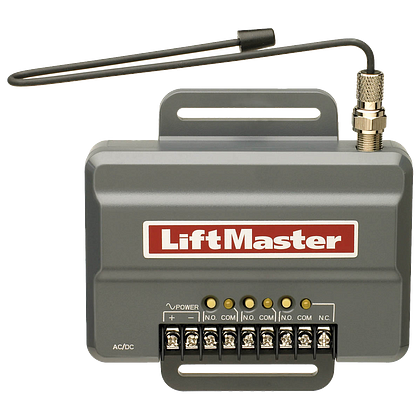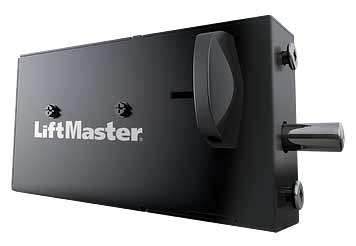The garage is often the most vulnerable area in the house, as it not only contains valuable possessions like vehicles but also, in many cases, serves as an access point to your home. Experienced burglars can take advantage of this vulnerability in various ways, such as using a stretched-out wire hanger to ‘fish’ for the emergency cord and disengage the door from the opener, making it manually operable.
Nevertheless, there are measures you can take to improve the security of your garage door and, by extension, your home. In this article, we’ll explore the most effective methods for improving your garage door security from inside and outside.
1. Rolling Code Garage Door Openers
The first generation of garage door openers used DIP switch technology for their receivers. This technology can make garage doors more vulnerable to intruders, as they may attempt to guess the switch combination being used to open the garage. If successful, they can gain access to the garage.

If you have an older garage door opener that utilizes DIP switch technology, you may want to consider replacing its receiver with a more secure one. Modern receivers use rolling code technology, which encrypts the signal and communicates using over 100 billion unique codes. It’s important to note that some opener models have their receivers integrated into the motherboard. To use rolling code technology, you’ll need to replace the entire garage door opener.
2. Use a Secure Keyless Entry Code
Keyless entry systems, such as keypads, require the garage door owner to program a code that connects the keypad to the garage door and allows it to open. Avoid using standard and simple codes like ‘1234’ or your house number, as they are not secure choices. It’s also advisable to avoid of using birthdays since social media can make such information easily accessible. Instead, choose a unique code that doesn’t have any obvious connection to your home or personal identity.
3. Secure Your Garage Door Remote
As simple as it may seem, avoid leaving your garage door remote control in your car, whether it’s visible or not. Even if your remote is clipped to the visor for easy access, it leaves your garage and, by extension, your home vulnerable to theft if the remote is stolen from your car.
Instead, consider carrying the remote with you or invest in a mini keychain remote that attaches to your keys for added convenience. Additionally, many cars come equipped with the HomeLink feature, which allows you to program your car to operate the garage door opener. This way, you won’t need to keep a remote control inside your car.
4. Secure Your Garage with a Lock
Utilizing an interior deadbolt or a garage door lock remains the most effective way to protect your garage against potential intruders. Modern electric deadbolts offer the convenience of automatic locking and unlocking via remote devices. However, not all opener models and brands are compatible with these automatic deadbolts.

For example, many modern Liftmaster and Chamberlain door openers are often compatible, while Genie, Marantec, and Linear models typically are not. If you choose to use a manual lock, you’ll need to exit your vehicle and physically lock and unlock the garage door. While this method may be less convenient and somewhat old-fashioned, it remains a reliable security solution.
5. Secure the Door from the Garage to Your Home
If your garage is attached to your house, make sure to lock and deadbolt the door that links your garage to your living space. In the event of a compromise of your garage door, you wouldn’t want your entire home’s security to be at risk.
6. Use Privacy Garage Door Windows
Just as you wouldn’t leave valuables on display in your car, the same logic applies to your garage. Clear windows on a garage door can make it easy for intruders to assess what’s inside, increasing the risk of theft of your car, tools, or other possessions. If security and privacy are a concern, consider tinting or frosting the garage door’s windows. This way, you can maintain natural sunlight while keeping the contents of your garage obscure and less visible. Alternatively, you can choose a windowless garage door.
7. Secure the Emergency Release Cord
Burglars can easily use a stretched-out wire hanger to reach through the door’s gaps, hook your emergency cord, and manually open the door. To prevent this, you can secure the opener’s trolley latch to the trolley itself using a zip tie. Another option is to consider removing the red emergency release cord. It’s important to note that in emergencies, using a zip tie may make it challenging to disengage the door from the opener, and removing the cord will also affect accessibility to the trolley’s latch.
Using privacy glass for your garage door’s windows can also help prevent unauthorized access to the emergency cord, as limiting an intruder’s view into your garage makes it more difficult for them to locate the emergency cord and attempt to open it manually.
8. Secure the Garage Exterior
Motion sensor lights are a classic deterrent for would-be thieves. When these lights suddenly activate, they draw the attention of passersby, making intruders nervous about the possibility of getting caught. Another option is to install surveillance cameras. Many high-end modern garage door openers come with built-in cameras, although the camera is typically located on the opener’s motor head inside the garage.
9. Strengthen Your Garage Doors
As obvious as it seems, but not all garage doors are equally strong and sturdy. Weaker doors can be vulnerable to intrusion, whether by kicking or cutting tools. Consider investing in a robust door, such as a wood garage door or a 3-layer insulated garage door, which offer improved structural strength and better security.
10. Upgrade Your Garage Door with Smart Technology
Forgetting to close the garage door is a common oversight, especially when rushing. Modern garage door openers come with built-in Wi-Fi connectivity systems (older openers can often be retrofitted). These smart garage door systems link to a dedicated smartphone app that sends alerts when the garage door is left open or when the door opener is in use. The app also provides real-time status updates, allowing you to monitor and control the garage door remotely from anywhere.
11. Keep Garage Doors Closed
Many residents keep their garage door shut and locked when they are not home or at night; however, they may leave it open or partially open when they are home. The problem is that it only takes a moment for anyone walking by to notice an open garage, step inside, grab something of value, and then be gone before you even know anyone was there.
12. Keep Garage Doors in Good Repair
Garage doors that are well maintained and kept in good working order greatly reduce the chances of burglary. Weakened locks, damaged panels, faulty opener, and other problems can give a determined thief an opportunity to make their way into your garage and home pretty easily.
Why Should You Secure Your Garage Door?
With over 1 million burglaries occurring every year in the United States, the burglary rate is 4.42 per 1,000 residents in Orange County, CA, and 2,178 per 100,000 residents in the entire state of California. Given the potential for break-ins everywhere, keeping your home and belongings safe is as easy as ensuring your garage is secure.
While no security measure can provide absolute protection, implementing these measures can substantially reduce the risk of a break-in and enhance your garage door’s security. If you have concerns or anxiety about the security of your garage door, it’s advisable to consult a licensed garage door repair company. They can offer valuable insights into common methods intruders may use to breach your garage door and recommend the best security measures to secure your garage and home within your local area.








Wow, these are some great garage door security tips. Our garage door has recently stopped working altogether. We’re looking for repairman to come out and take a look at it in the near future.